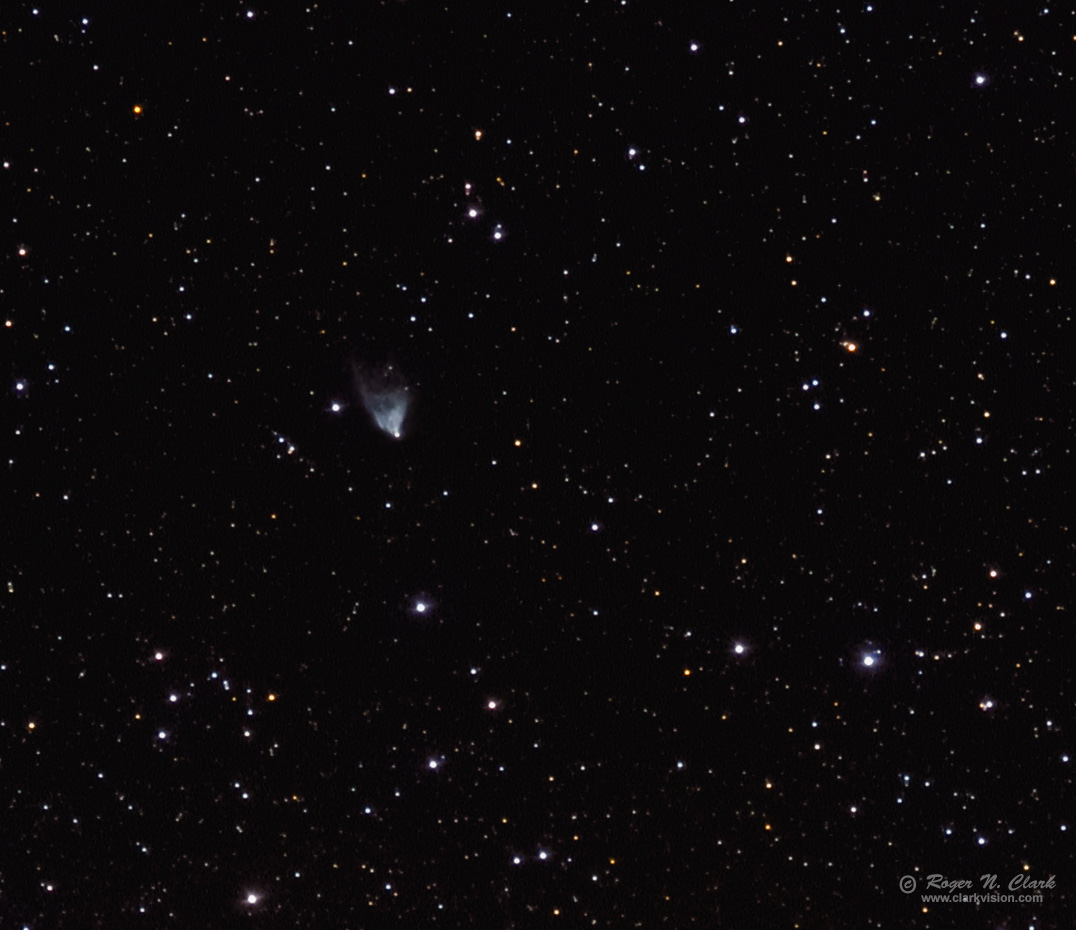| Home | Galleries | Articles | Reviews | Best Gear | New | About | Contact | Gallery Index | Previous |
Next |

| Home | Galleries | Articles | Reviews | Best Gear | New | About | Contact | Gallery Index | Previous |
Next |

Hubble's Variable Nebula in the constellation Monoceros, shows time varying structure apparently due to shadows cast by dense clouds near the star at the apex of the nebula in the image above. The blue color is light scattered from dust grains smaller than the wavelength of visible light. Its distance is about 2.5 light years. It is a small bright deep-sky object visible in small amateur telescopes. I have a drawing of it in my book Visual Astronomy of the Deep Sky made with an 8-inch telescope. This is a natural color image.
Technical. This image was obtained with a Canon 7D Mark II 20-megapixel digital camera and 300 mm f/2.8 L IS II lens plus a 2x teleconverter giving 600 mm at f/5.6, ISO 6400 and 1.4-arc-seconds per pixel. Note: the ISO 6400 was a mistake--I forgot to change the ISO after focusing. I had intended to make this image at ISO 3200. (Note: ISO does not change sensitivity.) Resolution is limited by seeing, atmospheric turbulence during the imaging session. Exposure time was 30 seconds per image with 20 frames obtained in a bright green zone on the light pollution scale. Total exposure time = 10 minutes. No dark frame subtraction, no flat fields. Tracking with an Astrotrac and no guiding. I elected shorter exposures because wind gusts were occasionally shaking the setup and I selected the best set of images from a longer time period. The image here is sampled at the full pixel resolution of 1.4 arc-seconds per pixel.
Post processing this small object required different methodology than I have usually done. Stacking many images had to be very accurate or spatial resolution would be compromised. Accurate alignment is the Achilles Heel of multi-exposure astrophotography. I have found stacking software often is poor, destroying fine detail (look for a future article about this in my astrophotography series). To make this image I did the following. I first aligned the images with translate only using ImagesPlus. That aligned the images to about a pixel. Then I fed that result into Deep Sky Stacker, turning off all calibration, and using 2x drizzle, which enlarged the images 2x. That aligned the images to 1/2 original pixel. The result was a well aligned stacked image with 0.7-arc-second per pixel sampling. The 10 minutes of exposure produced a high signal-to-noise ratio image for this relatively bright object, enabling Richardson-Lucy deconvolution to improve resolution mitigating the degradation from poor seeing. The deconvolved image was then adjusted for color using spectral classes of stars to guide color balance to make a natural color image.
The Exposure Factors, CEF, CEFA are measures of the relative amounts of light received from a subject. It can be used to fairly compare wildly different lens/telescope apertures and exposure times. For this image:
Modern DSLRs like the 7D Mark II include on sensor dark current suppression and low fixed pattern noise at ISOs around 1600 and higher, making no need for dark frame subtraction. Modern raw converters correct for light fall-off and also correct for hot/dead/stuck pixels. This makes processing low light images easy: simply align and average.
To learn how to obtain stunning images like this, please visit my Extensive Articles on Photography .
See my review of the Canon 7D Mark II and why it is so good for astrophotography: Canon 7D Mark II sensor analysis.
Keywords to this image = astrophoto-1 nebula low-light digital_astro canon_7d2
Image ID: hubbles-variable-nebula-600mm.c03.10.2016.0J6A8753-72-dss2x.g-c1s.jpg
| Home | Galleries | Articles | Reviews | Best Gear | Science | New | About | Contact |
Last updated November 03, 2025